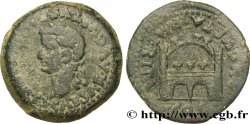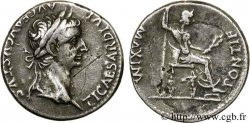v24_0246 - TIBERIO Denier fourré
MONNAIES 24 (2005)
起拍价 : 145.00 €
估价 : 200.00 €
竞价记录 : 145.00 €
出价数量 : 1
最高出价 : 165.00 €
起拍价 : 145.00 €
估价 : 200.00 €
竞价记录 : 145.00 €
出价数量 : 1
最高出价 : 165.00 €
种类 Denier fourré
日期: c. 15-37
铸币厂名称/城市 Gaule, Lyon (Lugdunum)
材质 silver
直径 19 mm
模子方针 2 h.
重量 2,64 g.
发行人: 4e
关于品相的说明
Beau portrait sur un flan large A été nettoyé anciennement. Un graffiti devant le nez. Trace de frappe incuse au revers. Une patine grise uniforme recouvre l’ensemble de la pièce
出版目录中的项代码 :
正面
正面的文字 TI CAESAR DIVI - AVG F AVGVS[TVS].
正面的说明书 Tête laurée de Tibère à droite (O*).
正面的翻译 “Tiberius Cæsar Divi Augusti Filius Augustus”, (Tibère César fils du divin Auguste, auguste).
背面
背面的文字 PONTIF - MAXIM.
背面的说明书 Pax (la Paix) ou Livie assise à droite sur un siège décoré, tenant une branche d'olivier de la main gauche et de la droite un long sceptre.
背面的翻译 “Pontifex Maximus”, (Grand pontife).
评论
Poids très léger, exemplaire fourré. Comme pour le denier d'Auguste, cette pièce appartient à l'atelier impérial de Lyon et ce type de denier a circulé pendant pratiquement un siècle. Il se rencontre très souvent avec des monnaies gauloises de la phase terminale dans les fouilles archéologiques. C’est la monnaie romaine la plus courante en Gaule pour les Julio-Claudiens. La quatrième émission se caractérise par un socle représenté par une ligne et les pieds du siège sont ornementés au revers ; au droit, les rubans de la couronne sont divergents.
Very light weight, filled example. As with the Augustan denarius, this coin belongs to the imperial mint of Lyon and this type of denarius circulated for almost a century. It is very often found with Gallic coins from the late phase in archaeological excavations. It is the most common Roman coin in Gaul for the Julio-Claudians. The fourth issue is characterized by a base represented by a line and the feet of the seat are ornamented on the reverse; on the obverse, the ribbons of the crown are divergent
Very light weight, filled example. As with the Augustan denarius, this coin belongs to the imperial mint of Lyon and this type of denarius circulated for almost a century. It is very often found with Gallic coins from the late phase in archaeological excavations. It is the most common Roman coin in Gaul for the Julio-Claudians. The fourth issue is characterized by a base represented by a line and the feet of the seat are ornamented on the reverse; on the obverse, the ribbons of the crown are divergent








 对产品描述纠错
对产品描述纠错 打印
打印 分享我的选择
分享我的选择 提问
提问 Consign / sell
Consign / sell
 产品介绍
产品介绍










